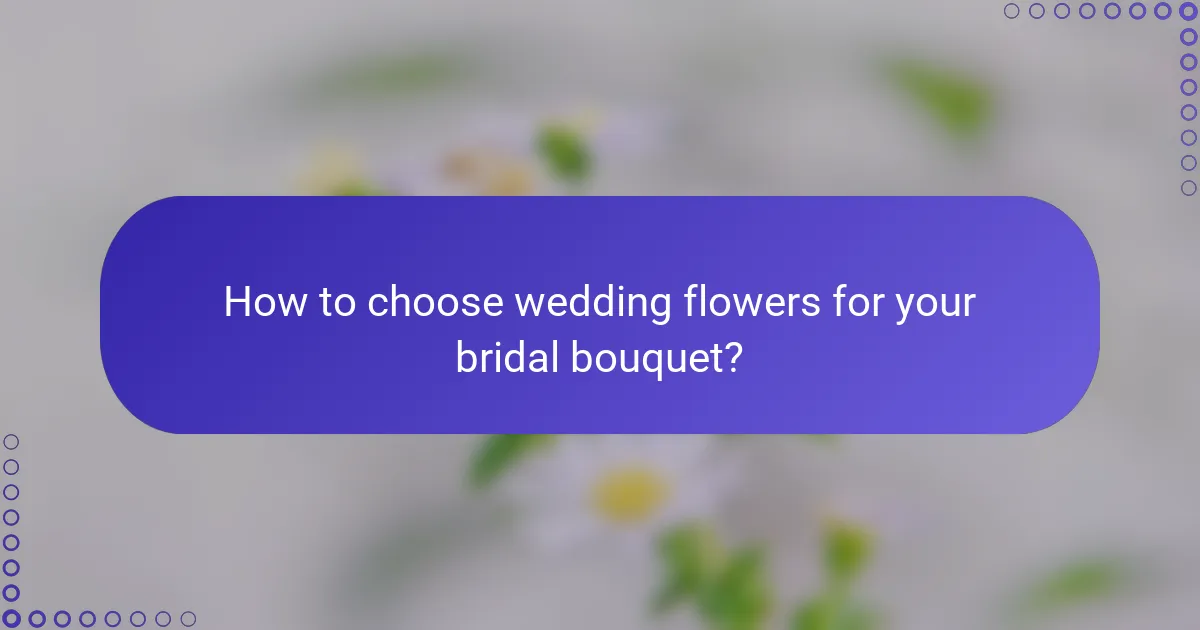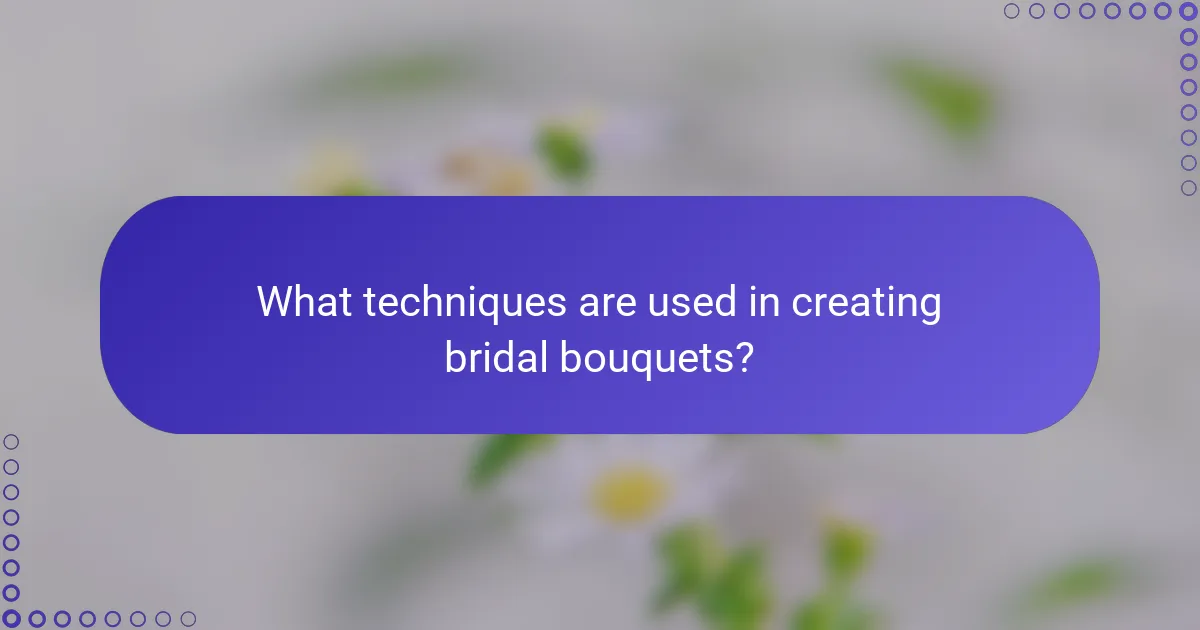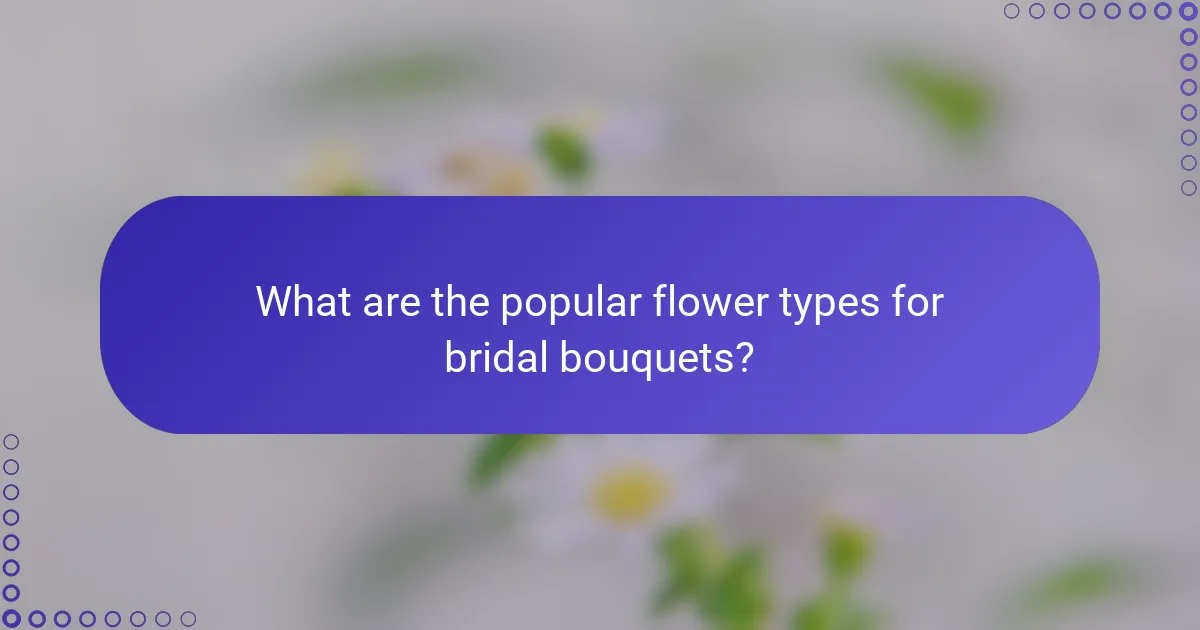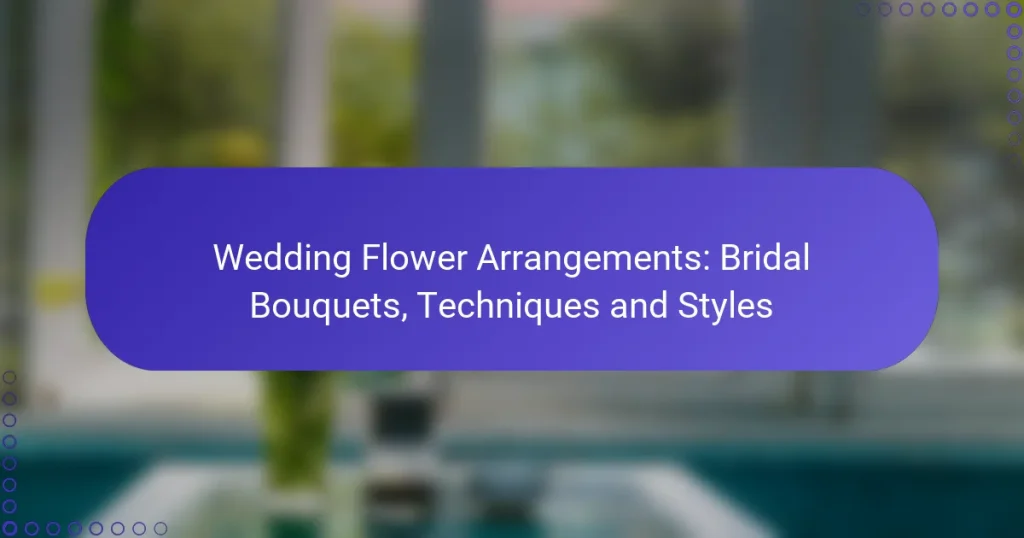Bridal bouquets are a vital element of wedding aesthetics, offering a range of styles that reflect personal taste and complement the overall theme. From classic round and cascade designs to modern hand-tied and wildflower arrangements, the options are vast. When selecting flowers, it’s essential to consider seasonal availability, color palettes, and the meanings behind each bloom to create a cohesive look. Additionally, employing various bouquet-making techniques can enhance both the beauty and stability of the arrangement.

What are the best bridal bouquet styles for weddings?
The best bridal bouquet styles for weddings include a variety of designs that cater to different themes and personal preferences. Classic options like round and cascade bouquets are popular, while more modern styles such as hand-tied and wildflower bouquets offer unique flair.
Classic round bouquet
The classic round bouquet is a timeless choice, characterized by its symmetrical shape and compact design. This style typically features a dense arrangement of flowers, creating a lush and full appearance that works well with traditional wedding themes.
When selecting a classic round bouquet, consider using flowers like roses, peonies, or hydrangeas. These blooms not only provide elegance but also come in various colors to match your wedding palette. Aim for a size that complements your gown without overwhelming your silhouette.
Cascade bouquet
The cascade bouquet, also known as a waterfall bouquet, features a trailing design that creates a dramatic effect. This style often incorporates long-stemmed flowers and greenery, allowing for a beautiful flow that adds movement to your bridal look.
For a cascade bouquet, choose flowers such as calla lilies or orchids, which lend themselves well to the elongated shape. Ensure that the length of the bouquet suits your height and dress style, as a well-proportioned cascade can enhance your overall appearance.
Hand-tied bouquet
A hand-tied bouquet is a more relaxed style, where flowers are gathered and tied together with ribbon or twine. This informal arrangement gives a natural, organic feel, making it ideal for outdoor or rustic weddings.
When creating a hand-tied bouquet, select a mix of seasonal blooms and greenery for a fresh look. This style allows for creativity, so feel free to experiment with different textures and colors. Just remember to keep the bouquet manageable in size for ease of carrying.
Pomander bouquet
The pomander bouquet, or kissing ball, is a spherical arrangement that can be carried or hung. This unique style is often made with tightly packed flowers and is a popular choice for flower girls or as an alternative to traditional bouquets.
To create a pomander bouquet, use flowers like carnations or roses, which can be easily shaped into a ball. Consider adding a ribbon for hanging or carrying, and keep the size small to maintain its delicate charm.
Wildflower bouquet
The wildflower bouquet embraces a free-spirited, bohemian aesthetic, featuring an assortment of colorful, seasonal blooms. This style is perfect for couples looking to incorporate a natural and whimsical vibe into their wedding.
When designing a wildflower bouquet, mix various flowers such as daisies, sunflowers, and lavender for a vibrant look. Aim for an unstructured arrangement that highlights the beauty of each flower, and consider adding herbs or foliage for added texture and fragrance.

How to choose wedding flowers for your bridal bouquet?
Choosing wedding flowers for your bridal bouquet involves considering factors like seasonal availability, wedding theme, color palette, and flower meanings. These elements will help ensure that your bouquet complements your overall wedding aesthetic and personal style.
Consider seasonal availability
Seasonal availability is crucial when selecting flowers for your bridal bouquet. Flowers that are in season are typically fresher, more vibrant, and less expensive than those that are out of season. For example, peonies are popular in late spring, while dahlias bloom in late summer to early fall.
To maximize your options, research local florists or flower markets to find out which blooms are available during your wedding month. This can help you avoid disappointment and ensure your bouquet is both beautiful and budget-friendly.
Match with wedding theme
Your bridal bouquet should align with your overall wedding theme, whether it’s rustic, elegant, vintage, or modern. For a rustic wedding, consider wildflowers or greenery, while an elegant affair might call for classic roses or orchids. Think about how the bouquet will complement your dress and the venue’s decor.
Discuss your vision with your florist, who can suggest flower combinations and arrangements that enhance your theme. Bringing inspiration images can help convey your ideas effectively.
Assess color palette
Assessing your color palette is essential for creating a cohesive look. Choose flowers that match or complement the colors in your wedding scheme. For instance, if your palette includes soft pastels, opt for blooms like blush roses or lavender hydrangeas.
Consider using a color wheel to identify complementary colors. This can help you create a bouquet that stands out while still harmonizing with your overall decor.
Evaluate flower meanings
Evaluating flower meanings can add a personal touch to your bridal bouquet. Many flowers carry symbolic meanings that can reflect your relationship or values. For example, lilies symbolize purity, while sunflowers represent adoration and loyalty.
Incorporating flowers with special meanings can make your bouquet more meaningful. Discuss these options with your florist to create a bouquet that tells your unique love story.

What techniques are used in creating bridal bouquets?
Creating bridal bouquets involves various techniques that enhance the beauty and stability of the arrangement. Each technique offers unique benefits and can influence the overall look and feel of the bouquet.
Floral foam technique
The floral foam technique involves using a special foam that absorbs water, providing hydration to the flowers. This method allows for greater flexibility in arranging blooms, as the foam holds stems securely in place.
When using floral foam, soak it in water before inserting the flowers to ensure they remain fresh. This technique is particularly useful for larger bouquets that require a stable base.
Wire and tape technique
The wire and tape technique uses floral wire to reinforce stems and floral tape to secure them together. This method is ideal for creating intricate designs and allows for more control over the shape and structure of the bouquet.
To use this technique, cut the stems to the desired length, wrap them with wire, and then cover the wire with floral tape. This approach is effective for delicate flowers that may not hold up well on their own.
Binding technique
The binding technique involves tightly wrapping the stems of the flowers together with string or ribbon. This creates a cohesive look and can be customized with various materials to match the wedding theme.
When binding, ensure the stems are cut evenly and positioned at the desired angle. This technique is straightforward and works well for both simple and elaborate bouquets.
Natural stem technique
The natural stem technique showcases the flowers’ stems without additional support. This method emphasizes the organic beauty of the blooms and is often used for more rustic or wildflower arrangements.
For this technique, select flowers with sturdy stems and arrange them in a way that highlights their natural form. This approach is best for bouquets intended for outdoor weddings or casual settings.

What are the popular flower types for bridal bouquets?
Bridal bouquets often feature a variety of popular flower types that enhance the overall aesthetic of the wedding. Key choices include roses, peonies, lilies, hydrangeas, and sunflowers, each offering unique beauty and symbolism.
Roses
Roses are a timeless choice for bridal bouquets, symbolizing love and passion. They come in various colors, allowing couples to match their bouquets with wedding themes or personal preferences.
When selecting roses, consider their size and bloom type. Garden roses offer a lush, romantic look, while standard roses provide a classic appearance. Aim for a mix of sizes to create visual interest.
Peonies
Peonies are beloved for their lush, full blooms and sweet fragrance, making them a popular choice for spring and summer weddings. They symbolize romance and prosperity, adding a touch of elegance to any bouquet.
Due to their seasonal availability, peonies can be more expensive than other flowers. Plan ahead to ensure you can source them fresh, ideally from local florists who can provide the best quality.
Lilies
Lilies bring a striking and sophisticated element to bridal bouquets, known for their large, dramatic blooms and pleasant scent. They symbolize purity and refined beauty, making them suitable for various wedding styles.
Consider using different lily varieties, such as calla lilies for a modern look or stargazer lilies for a bold statement. Be mindful of their fragrance, as some guests may be sensitive to strong scents.
Hydrangeas
Hydrangeas are popular for their voluminous blooms and range of colors, making them ideal for creating lush bouquets. They symbolize gratitude and understanding, adding a meaningful touch to the wedding day.
These flowers work well as filler or focal points in arrangements. However, they can wilt quickly, so ensure they are well-hydrated before the ceremony. Pair them with sturdier flowers for longevity.
Sunflowers
Sunflowers are a cheerful and vibrant choice for bridal bouquets, representing adoration and loyalty. Their bright yellow petals can add a pop of color, perfect for rustic or outdoor weddings.
When using sunflowers, consider their size and how they will complement other flowers in the bouquet. They pair well with wildflowers or greenery, creating a relaxed, natural look. Ensure they are fresh to maintain their vibrant appearance throughout the day.

How to preserve bridal bouquets after the wedding?
Preserving bridal bouquets after the wedding can help maintain their beauty and sentimental value. Common methods include air drying, pressing, and using silica gel, each offering different aesthetics and longevity.
Air Drying
Air drying is one of the simplest methods to preserve a bridal bouquet. To do this, hang the bouquet upside down in a cool, dark place with good air circulation. This process can take several weeks, but it results in a natural, rustic look.
Ensure the flowers are not touching each other to prevent mold. Once dried, you can display the bouquet in a shadow box or vase, keeping it away from direct sunlight to prevent fading.
Pressing
Pressing flowers is another effective preservation technique that results in flat, delicate blooms. To press a bouquet, place the flowers between sheets of parchment paper and use a heavy book or a flower press to apply even pressure.
This method typically takes a few weeks. Once pressed, the flowers can be framed or used in crafts, but they may not be suitable for three-dimensional displays.
Using Silica Gel
Using silica gel is a more advanced preservation method that retains the flowers’ original shape and color. Submerge the bouquet in silica gel in an airtight container, ensuring all petals are covered. This process usually takes about a week.
After removing the bouquet, gently brush off any excess silica gel. This method can be more costly but offers a vibrant and lifelike appearance, making it a popular choice for preserving wedding flowers.


